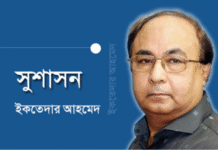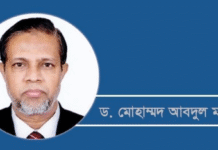Mahmudur Rahman Choudhury

Bangladesh Bureau of Statistics (BBS) in its Bangladesh Literacy Survey — 2011 figures published in June 2014 — states that 57.70 percent of the country’s population aged 15 and over is literate. The BBS defines literacy very narrowly, as the ability to “write a letter for communication”. What the BBS report does not indicate is how many of the literate people have the competence, skills, and training to find gainful employment or earn livelihoods at home or abroad. One can imagine the figure in that respect is not impressive.
The first step, obviously, is to achieve universal national literacy, if one defines literacy as the ability to read, write and do arithmetic. But having nearly achieved that, it is time now to go beyond the “literacy rate” debate and have a deep look at the “utility” aspect of such literacy. The moral and social values of literacy lose much of their weight as soon as they come up against the hard facts of economic utility at both the individual and the collective levels.
What people need are competencies and skills giving them the expertise to work in manufacturing, agriculture or services. Trying to improve the literacy rate is doing a very small part of the job; the greater part lies in converting human beings into such resources by providing them with required education to be gainfully employed. “Stomach first” may be a cliché but it holds good.
The Awami League’s pledge to eradicate illiteracy by 2020 is important but an even more worthwhile goal would be to make the presently literate people competent and skilled in some way to earn a living. The debate over education policy ought to be guided towards looking for ways of achieving that.
Different Orientations – Different Societies
Clearly there are three different orientations running parallel through all four tiers – primary, secondary, tertiary and higher – of our education system. The first of these is the vernacular or Bangla medium, which caters to the need for education of the vast majority of the children, from the villages to metropolitan cities. It is to this that the government directs most of its efforts, providing funding, direction and control. And yet, it is the weakest of the three orientations.
The second, which also caters to a large extent to the needs of the masses, is religion-based education through Madrasas. It is the dispossessed, the utterly poor, the abandoned and a section of the lower middle class who are targeted by the Madrasas, providing them with not only education but also shelter. Madrasa education is neither very pragmatic nor very much attuned to the practical requirements of life and living but it fulfils the important function of “socialising” the most downtrodden portion of the population, with a life long sense of belongingness and bonding to a particular social group – functions which secular education is demonstratedly incapable of performing.
The third orientation is English medium which sees to the education of the offspring of the rich and the affluent in the big cities. Aligned and attuned to British and US modes of education, this is perhaps the most rapidly growing sector of our education. Managed and operated like big businesses, it is open to question how much and what education those institutions provide to produce useful citizen for our Nation attuned to the cultural and social proclivities of our people.
From even a cursory look at these orientations, it becomes clear that we are in fact dealing here with three different cultures, each with distinctly different outlooks, attitudes, beliefs, customs, traditions and even language. Therefore, instead of coalescing our society and ultimately our nation, this education is getting us increasingly fragmented into culturally exclusive groups with little inter-group commonality but considerable areas of discordance and even conflict among them. On one side is the vast mass of population more or less oriented towards Bangaliness in language and education; on the other, is a very small coterie of young people with western oriented language and education; in the middle is the considerable number of people with Madrasa education.
Weaknesses are many, chief among which are endemic corruption in the government structures controlling the system, a lack of clear policy and direction, and lack of a formal structure for setting and reviewing policies based on consensus of the major stakeholders such as educationists, teachers and public officials. The outcome of these weaknesses are an unhappy blend of poor teaching materials such as text books, poor teachers in both intellectual and monetary sense and a unsatisfactory, largely impractical education for our children. It is therefore, self-evident that such a system produces mass literacy of sorts but not education conducive to creating a productive, pragmatic, tolerant and aware citizenry so necessary for the continued prosperity and growth of our society and nation-state.
Perhaps one of the major reasons for our social and political unrest is the lack of concordance in our education system, for as we have seen our education system has created and is now reinforcing divisive trends in our society.
Source: Bd news24









